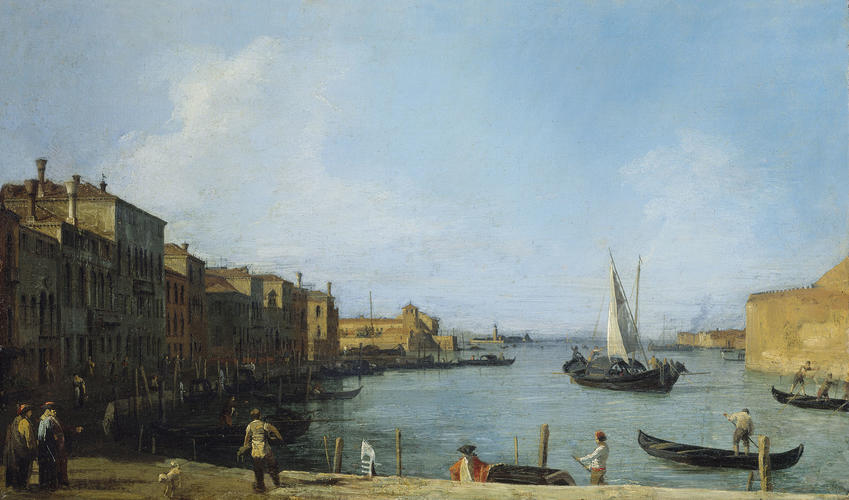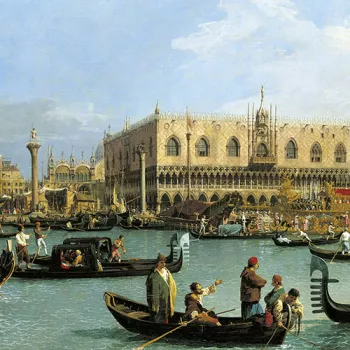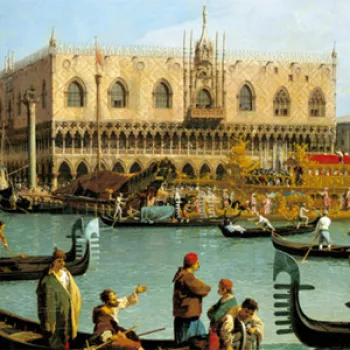The Canale di Santa Chiara looking North towards the Lagoon c. 1722-3
Oil on canvas | 46.7 x 77.9 cm (support, canvas/panel/stretcher external) | RCIN 401403
-
This is one of a series of twelve views by Canaletto of the Grand Canal which are all the same format. The pictures form the basis of the fourteen engraved plates in Visentini's 'Prospectus Magni Canalis Venetiarum' (Venice, 1735), thus providing an uncontested date for completion. It is thought that they originated in the years around 1730. The paintings were all acquired by George III with the collection of Consul Smith.
At its far north-west, the Grand Canal makes a final sharp turn to pass the island and convent of Santa Chiara before opening on to the lagoon. The view is taken looking north-west from the Fondamenta della Croce. To the left are the shadowed façades of the buildings lining the Fondamenta di Santa Chiara, leading to the convent of the same name across its side canal. At the right is the wall of the convent of Corpus Domini, with houses at the far west of Cannaregio beyond, the island of San Secondo in the distance, and the hills of the mainland suggested along the horizon.
The three buildings at far left survive, but a low nineteenth-century office building now occupies the rest of the Fondamenta, and one of the vaporetto (water bus) stops serving the Piazzale Roma car park stands in the left foreground. Both Santa Chiara and Corpus Domini were suppressed in the Napoleonic period. Santa Chiara is now a military hospital, and Corpus Domini was one of the many buildings demolished around 1860 to make way for the railway station, whose sidings sit on reclaimed land (incorporating San Secondo) across the right of the view.
On grounds of style and technique, the painting must be the earliest of Smith's Grand Canal views. Canaletto prepared his canvas with a reddish-brown ground, over which he laid an underpaint of a range of colours for different areas of the painting: a graduated grey for the sky, dark grey for the water, and orange-brown for the buildings, which can clearly be seen in places. This technical feature, which is not found in the other Grand Canal paintings, is shared with the sequence of large paintings around San Marco, along with the dramatic quality of light, the bold handling of paint, and the relatively large size of the foreground figures. It has recently been argued that the painting may be of an earlier date c.1722-3, partly in consequence of a general redating of Canaletto's first paintings.
The painting is unique in the Grand Canal series in the interest accorded to the foreground figures. The building second from the left, marked by a round sign on its balcony was the residence of the British Secretary-Resident, and the man gesturing prominently at lower left, who from his dress cannot be Venetian, has been cautiously identified as Colonel Elizaeus Burges, the Secretary from 1719 to 1722 and from 1728 until his death in 1736 (and thus not the Secretary at the time that this painting was probably executed). A version of the painting with the Fondamenta in bright sunlight now in a private collection shows an important personage being received from a gondola outside that building.
Catalogue entry adapted from Canaletto in Venice, London, 2005.
Provenance
Acquired in 1762 by George III from Joseph Smith, British Consul in Venice (Italian List nos 65-76); recorded in the Gallery at Kew in 1805 (no 20)
-
Medium and techniques
Oil on canvas
Measurements
46.7 x 77.9 cm (support, canvas/panel/stretcher external)
65.5 x 97.8 x 9.9 cm (frame, external)
Category
Object type(s)
Other number(s)
Alternative title(s)
Venice: The Canale di S. Chiara towards the Lagoon
On the Grand Canal, Venice










